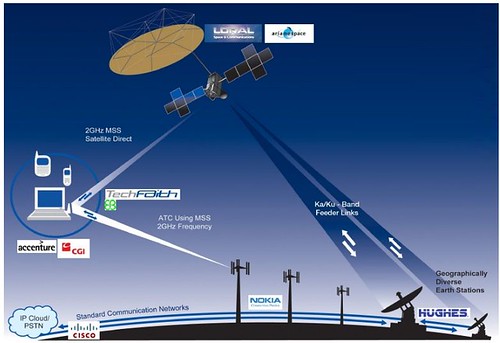TerreStar Genus: Can Anyone Hear Me?
Posted by Sam Churchill on November 23rd, 2010 The TerreStar Genus smartphone has debuted a consumer version of its dual-mode satphone. The pocket-size phone can directly access both TerreStar’s geosynchronous satellite and AT&T’s terrestrial cellular network.
The TerreStar Genus smartphone has debuted a consumer version of its dual-mode satphone. The pocket-size phone can directly access both TerreStar’s geosynchronous satellite and AT&T’s terrestrial cellular network.The Genus was made available to business customers back in September for $800. Now it’s available to anyone for $1,149.99.
The Genus is a rugged Windows Mobile 6.5 smartphone with a full QWERTY keyboard. For businesses, the option to be able to switch over to the satellite costs $25 extra per month, and then 65 cents per minute of calling. The handset can be ordered directly from TerreStar, but requires a new AT&T contract.
TerreStar promised to hand off to AT&T’s terrestrial cellular network (using their Genus satphone) when local service was available. It’s been more talk than action.
TerreStar launched their first satellite over a year ago, and declared bankruptcy on Oct 19, 2010. A last minute EchoStar loan of $75 million was approved, over opposition from TerreStar creditors. It will provide the funding for TerreStar Networks’ exit from Chapter 11. Under the proposed restructuring, EchoStar, based in Englewood, Colorado, and other secured noteholders would swap more than $940 million in debt for 97 percent of TerreStar’s equity, according to court papers.
TerreStar launched their first satellite over a year ago, and declared bankruptcy on Oct 19, 2010. A last minute EchoStar loan of $75 million was approved, over opposition from TerreStar creditors. It will provide the funding for TerreStar Networks’ exit from Chapter 11. Under the proposed restructuring, EchoStar, based in Englewood, Colorado, and other secured noteholders would swap more than $940 million in debt for 97 percent of TerreStar’s equity, according to court papers.
TerreStar’s bankruptcy could be a good thing, like the fate of Globalstar and Iridium ten years ago. Those LEOs emerged from bankruptcy largely debt-free.
TerreStar has a footprint that covers 330 million people throughout the United States and Canada. TerreStar-1 has an antenna approximately 60 feet across that enables it to communicate with wireless devices the size of regular cell phones.
Using licensed 2GHz radio spectrum, it can provide voice service as well as data at approximately 64K bits per second, said TerreStar Chief Technology Officer Dennis Matheson. The handsets will switch between satellite and 3G coverage as users roam in and out of cellular coverage areas.
TerreStar shares MSS (2 GHz) spectrum with Craig McCaw’s ICO. McCaw’s ICO, also in the 2 GHz band, launched ICO G1 in April 2008, the largest commercial satellite ever launched at the time. But ICO does not yet offer service, and is still emerging from bankruptcy as DBSD Satellite Services.
The Lightsquared satellite, SkyTerra-1, was successfully launched just last week. Lightsquared service are not yet available. It will use the lower frequency L-band at 1.6 GHz. Lightsquared hopes to build its own terrestrial LTE network– using their 1.6 GHz frequency — after they raise a few billion dollars.
TerreStar, ICO and Lightsquared have now launched huge, competitive, and expensive geosynchronous satphone platforms. But their spectrum may be more valuable back on the ground.
TerreStar, ICO and Lightsquared have now launched huge, competitive, and expensive geosynchronous satphone platforms. But their spectrum may be more valuable back on the ground.
 The FCC’s new regulations allowed satphone providers to offer terrestrial repeaters, operating like cell towers. Satellite phone providers argued that (ATC) service was necessary to sustain their business — otherwise satphone signals couldn’t penetrate inside cars or buildings.
The FCC’s new regulations allowed satphone providers to offer terrestrial repeaters, operating like cell towers. Satellite phone providers argued that (ATC) service was necessary to sustain their business — otherwise satphone signals couldn’t penetrate inside cars or buildings.FCC rulemaking permits Mobile Satellite Service (MSS) licensees in the 2 GHz (1990-2025 MHz and 2165-2200 MHz) bands (where ICO and Terrastar operate), the L-band (1525-1544 MHz/1545-1559 MHz) and 1626.5-1645.5 MHz/1646.5-1660.5 MHz) bands (where Inmarsat and Skyterra operate), and the “Big LEO” (1610-1626.5 MHz and 2483.5-2500 MHz) bands (where Globalstar and Iridium operate).
Tim Farrar reminds us that Wall Street analysts in the late 1990s predicted that the MSS industry would generate tens of billions of dollars in annual revenues within a few years. Not necessarily so.
 Harbinger Capital Partners, a hedge fund, backed both the wholesale LTE venture LightSquared and TerreStar. Now the company is being investigated by federal authorities over a $113 million loan taken out by Harbinger founder Philip Falcone to pay personal taxes, notes Fierce Wireless. The investigation is also looking at whether the fund gave preferential treatment to some investors, reports Bloomberg.
Harbinger Capital Partners, a hedge fund, backed both the wholesale LTE venture LightSquared and TerreStar. Now the company is being investigated by federal authorities over a $113 million loan taken out by Harbinger founder Philip Falcone to pay personal taxes, notes Fierce Wireless. The investigation is also looking at whether the fund gave preferential treatment to some investors, reports Bloomberg.




No comments:
Post a Comment